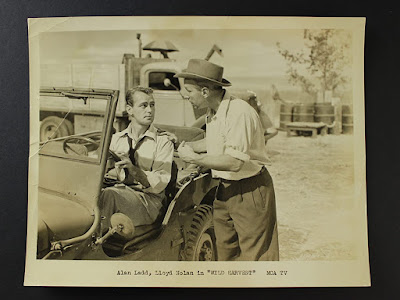Many years later, when World War II got itself over with, a movie company from Hollywood decended on the Connell-Lind district. Seeing all that wheat waving in the wind, they hurriedly unloaded their cameras and rounded up all the Massey-Harris self-propelled combines they could lay their hands on.
“Oh goody," a bunch of us guys said to ourselves; a harvest story made in the northwest using the same self-propels that a lot of us early buyers experimented with. The movie was called, “Wild Harvest”, starring Dorothy Lamour and Alan Ladd. Our thoughts ran illusive. Maybe we could learn how to harvest Hollywood style.
When “Wild Harvest” came to Spokane, Sugar and I made it a foursome by taking Sugar’s sister and future brother-in-law. George wasn’t sold on self-propels at that time, so I thought this movie would be an excellent opportunity to get his brain changed over to accepting advance harvesting methods.
When the popcorn sacks were half empty, it was apparent that this picture would not walk off with any Oscars. The only realistic scene that struck home was the harvest crew eating their noonday lunch under the shade of the combines. A tired and bored housewife did kick up her heels and began horsing around with the harvest crew, causing stress to set in on the movie viewing farmers that took their spouses for granted.
In no time, the wild stuff began making wild things happen in “Wild Harvest.” Combines were being pushed off of speeding trucks, with the idea of slowing down a rival harvest gang that was muscling in on their harvest brigade operations. Young Mielke went to sleep on his fiance’s shoulder. It just wasn’t the right picture show to convince George that he should change over to self-propelled combines.
"Harvesting Hollywood Style", Kik-Backs, page 27, part 2 (previous) (home) (thread)





Comments
Post a Comment